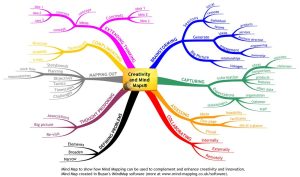Note-Taking Strategies
You may have a standard way you take all your notes for all your classes. When you were in high school, this one-size-fits-all approach may have worked. Now that you’re in college reading and studying more advanced topics, your general method may still work some of the time, but you should have some different strategies in place if you find that your method isn’t working as well with college content. You probably will need to adopt different note-taking strategies for different subjects. The strategies in this section represent various ways to take notes so that you are able to study after the initial note-taking session.

Cornell Method
One of the most recognizable note-taking systems is called the Cornell Method, a relatively simple way to take effective notes devised in the 1940s by Cornell University education professor Dr. Walter Pauk. In this system, you take a standard piece of note paper and divide it into three sections by drawing a horizontal line across your paper about one to two inches from the bottom of the page (the summary area) and then drawing a vertical line to separate the rest of the page above this bottom area, making the left side about two inches (the recall column) and leaving the biggest area to the right of your vertical line (the notes column). You may want to make one page and then copy as many pages as you think you’ll need for any particular class, but one advantage of this system is that you can generate the sections quickly.
Because you have divided up your page, you may end up using more paper than you would if you were writing on the entire page, but the point is not to keep your notes to as few pages as possible. The Cornell Method provides you with a well-organized set of notes that will help you study and review your notes as you move through the course. If you are taking notes on your computer, you can still use the Cornell Method in Word or Excel on your own or by using a template someone else created.
Now that you have the note-taking format generated, the beauty of the Cornell Method is its organized simplicity. Just write on one side of the page (the right-hand notes column) — this will help later when you are reviewing and revising your notes. During your note-taking session, use the notes column to record information about the main points and concepts of the lecture; try to put the ideas into your own words, which will help you understand your notes when you return to them later. To keep your note section organized, skip lines between each idea in this column and use bullet points or phrases to convey meaning — we do it all the time in conversation. Sometimes it is important to move quickly to keep up, so try to use abbreviations and avoid writing in complete sentences to keep your notes brief without losing the meaning of your writing. If you know you will need to expand the notes you are taking in class but don’t have time, you can put reminders directly in the notes by adding and underlining the word expand next to the ideas you need to develop more fully.
As soon as possible after your note-taking session, preferably within eight hours but no more than a day, read over your notes column and fill in any details you missed in class, including the places where you indicated you wanted to expand your notes. Then in the recall column, write any key ideas from the corresponding notes column — you can’t stuff this smaller recall column as if you’re explaining or defining key ideas. Just add the one- or two-word main ideas; these words in the recall column serve as cues to help you remember the detailed information you recorded in the notes column.
Once you are satisfied with your notes and recall columns, summarize this page of notes in two or three sentences using the summary area at the bottom of the sheet. This is an excellent time to get together with another classmate or a group of students who all heard the same lecture, read the same reading, or watched the same video to make sure you all understood the key points. Now, before you move onto something else, cover the large notes column, and quiz yourself on the key ideas you recorded in the recall column. Repeat this step often as you go along, not just immediately before an exam, and you will help your memory make the connections between your notes, your textbook reading, your in-class work, and assignments that you need to succeed on any quizzes and exams.

Outlining
Other note-organizing systems may help you in different disciplines. You can take notes in a formal outline if you prefer, using Roman numerals for each new topic, moving down a line to capital letters indented a few spaces to the right for concepts related to the previous topic, then adding details to support the concepts indented a few more spaces over and denoted by an Arabic numeral. You can continue to add to a formal outline by following these rules.
You don’t absolutely have to use the formal numerals and letter, but you have to then be careful to indent so you can tell when you move from a higher level topic to the related concepts and then to the supporting information. The main benefit of an outline is how organized it is. You have to pay attention when you are taking notes in class to ensure you keep up the organizational format of the outline, which can be tricky if the lecture or presentation is moving quickly or covering many diverse topics.
You continue on with this numbering and indenting format to show the connections between main ideas, concepts, and supporting details. Whatever details you do not capture in your note-taking session, you can add after the lecture as you review your outline.
Concept Mapping and Visual Note-Taking
One final note-taking method that appeals to learners who prefer a visual representation of notes is called mapping or sometimes mind mapping or concept mapping, although each of these names can have slightly different uses. There are many different forms of visual note-taking, so you may want to look for more versions online, but the basic principles are that you are making connections between main ideas through a graphic depiction; some can get rather elaborate with colours and shapes, but a simple version may be more useful at least to begin. Main ideas can be circled or placed in a box with supporting concepts radiating off these ideas shown with a connecting line and possibly details of the support further radiating off the concepts. You can present your main ideas vertically or horizontally, but turning your paper horizontally, or in landscape mode, may prove helpful as you add more main ideas.
You may be interested in trying visual note-taking or adding pictures to your notes for clarity. Sometimes when you can’t come up with the exact wording to explain something or you’re trying to add information for complex ideas in your notes, sketching a rough image of the idea can help you remember. Don’t shy away from this creative approach to note-taking just because you believe you aren’t an artist; the images don’t need to be perfect.
You can play with different types of note-taking suggestions and find the method(s) you like best, but once you find what works for you, stick with it. You will become more efficient with the method the more you use it, and your note-taking, review, and test prep will become, if not easier, certainly more organized, which can decrease your anxiety.


